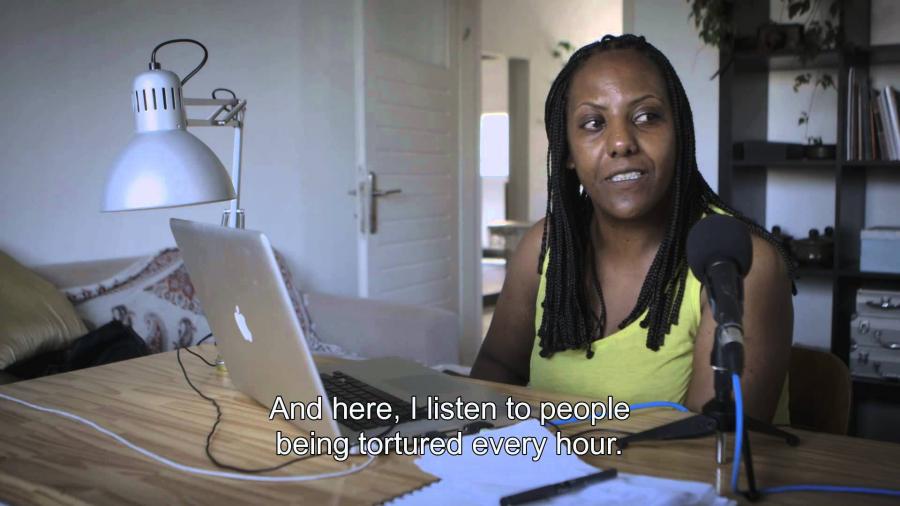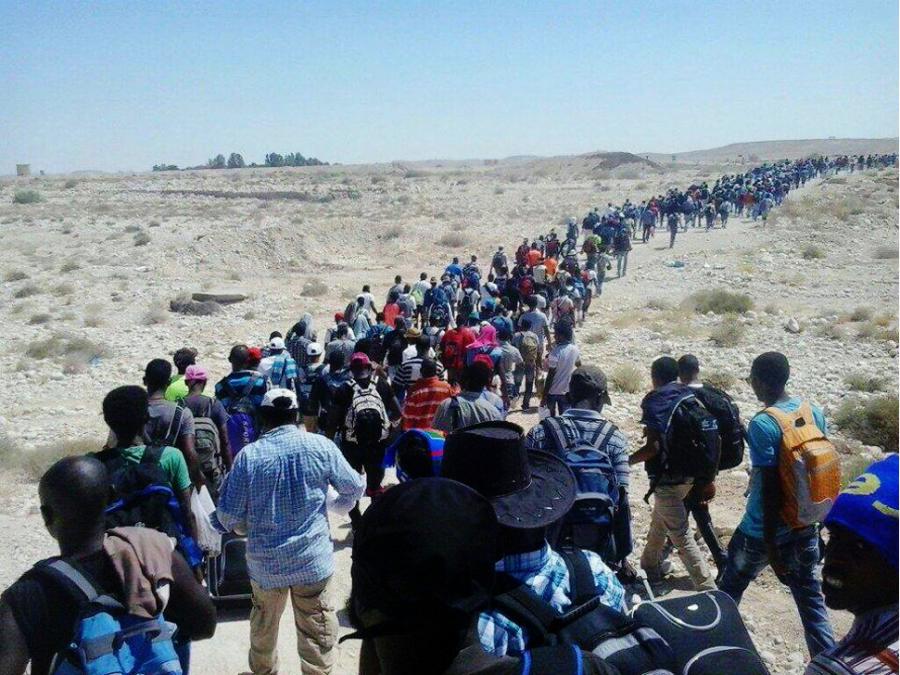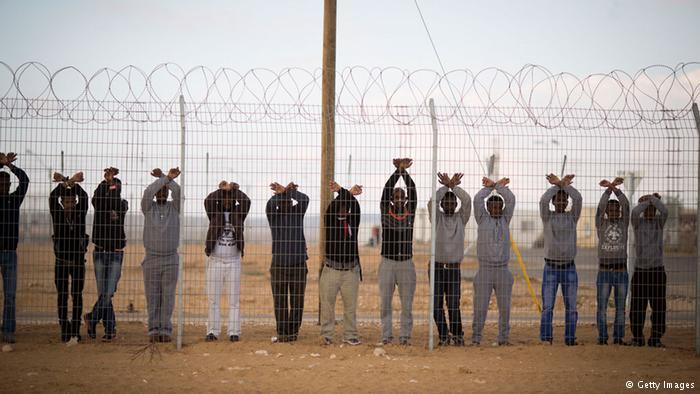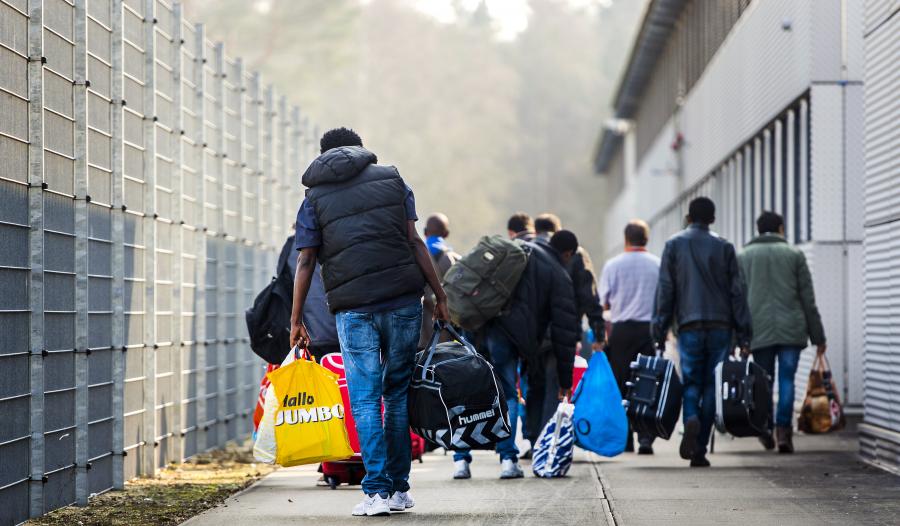
Pricetag for a 'better' life: tangible and intangible borders that refugees have to deal with
Ever wondered what torture sounds like? In the documentary ‘Sound of torture,’ you can get a taste of it. This documentary reveals how Eritrean refugees, who have fled their country towards Israel, get kidnapped, tortured and raped as they are forced to call their relatives, begging for ransom, prices of thousands of dollars (Shayo, 2013). Watching this shocking documentary makes your stomach turn. It is hard to imagine that people would hurt other people in such horrible ways. It makes you wonder why people put their lives at risk. One can only imagine that people flee their motherland because they are searching for a better future in another country. But do they really achieve this better life? For example, how welcome are refugees nowadays in Dutch society? Questions like these are the premise of this article, which focuses on several tangible and intangible borders that refugees from Eritrea – as just one example – have to cross in order to 'navigate' to and ‘integrate’ into another country, culture, and society.

Refugees escaping two-faced Eritrea
Censorship in Eritrea is, what some call, the most oppressive of the world (The economist, 2017), and media beyond the state-sanctioned newspapers and TV are non-existent (BBC, 2017). Information about Eritrea is mainly coming from sources outside of Eritrea. The stories which seem to be coming from inside the country are completely contradicting with stories from outside the country. For example, while reading the official website of the Embassy of the state of Eritrea (n.d.), which is written in English, it claims that the government invests heavily in healthcare, social welfare, education and skill development sectors. They also imply that the government provides access to these services for all its citizens, regardless of their ethnic or religious backgrounds, their geographical locations, their gender, age or other social categories (Embassy of the state of Eritrea, n.d.).
"Does a refugee, after crossing the border to an asylum country, face a promising future?"
However, this image does not fit the second image of Eritrea that is shaped by the abundance of different horrifying stories that come from, e.g., refugees from Eritrea. Among others, VluchtelingenWerk Nederland – Dutch Refugee Work – (n.d.) explains that many people flee their home country because of the obligatory military service. This service officially lasts eighteen months but, in reality, can last more than ten years. In addition, Eritreans remain reservists for service until their fiftieth. If someone refuses, they can be cruelly punished and family members are at risk of being arrested. Other motives to flee the country include (VluchtelingenWerk Nederland, n.d.; Hackey, 2015; Human Rights Concern Eritrea, 2015):
- Eritrea is one of the worst dictatorships in the world and since 1993 no national elections have been held. The government remains in power through terror, mass surveillance, widespread torture, arbitrary detention and forced labor (Hackey, 2015).
- Criticism of the government is not tolerated. Critics of the ‘regime’ are at high risk of being arrested, tortured, and abused. Furthermore, there is no freedom of the press, which means that critical journalists are in danger.
- In Eritrea, not all religions are recognized which causes religious minorities to be at risk of prosecution.
- Finally, the United Nations accuses the leaders of Eritrea of crimes against humanity. The inquiry found that they committed crimes including enslavement, imprisonment, disappearances, torture, rape, and murder (Cumming-Bruce & Gettleman, 2016). Given all of this, it sounds reasonable that a large number of Eritreans want to leave their country.
If a person decides to flee Eritrea, there are not many options, since Eritreans are not allowed to leave their country without the permission of the Eritrean authorities, a permission which is hard to get. Considering that Eritrea is believed to have a shoot-to-kill policy to stop people from fleeing the country (Reuters, 2017), anyone who does try to flee the country illegally takes the risk of paying with their life (Plaut, 2017). As soon as someone just thinks about leaving Eritrea, they already have to think about the financial aspect of traveling. And after fleeing the country, the complex journey of an Eritrean refugee has only just begun.
To leave is a game of risks and costs
What does it mean to flee a country? For an Eritrean refugee, it would mean to be able to get to either Ethiopia, Sudan or to cross the Sinai desert to get into Israel with all the risks that come with it. One example is the risk of being kidnapped by human traffickers that can take you away for money extortion while crossing the Sinai desert. It also means going days without food and water. Another risk is trying to cross over fences to enter a new country and risk to get shot by the police of that new country (Shayo, 2013).

Nowadays, a new generation of refugees, who are young and well-educated, often turn to Sudan as a transit state, where they stay for a while before they move further. Those that want to make it to Europe try to cross the Mediterranean from North Africa in order to reach Europe (Hoskins, 2011). Most of the refugees use Sudan or Ethiopia as the first stop on their journey towards final settlement elsewhere. This is a temporary refuge in order to migrate to a third country where the payoffs are greater than the risks. The new generation leaves by airplane at great risk because fleeing by taking a flight means that you are “voting with your feet”, an act condoned by the government. The Eritrean government authorizes the immediate killing of those caught while fleeing. So, does a refugee, after crossing the border to an asylum country, face a promising future? Not necessarily, because they are not received with arms wide open. They are received with an anti-refugee environment in the new developing countries due to political and economic factors (Bariagaber, 2013).
"When, finally, arrived at the borders of the country where an asylum seeker tries to seek safe haven, s/he is greeted 'within a regime of suspicion'."
As Andersson (2014) discusses in ‘Illegality, Inc.’, crossing borders is a game of risks and prices that you have to pay. But not only the refugees have to reach into their pockets. A lot of money is spent by governments on radars, satellites, advanced computer systems, and patrols by sea, land, and air to avoid migrants from leaving their African home. The target is the illegal immigrant. Borders these days are not just policed with trucks and guns, they have become harder to cross as a result of new migration laws, new surveillance software and remote visa controls (Andersson, 2014, p.67).

As discussed above, refugees tend to travel through a transit state. This state is their first stop for asylum seeking. With pressure coming from wealthier and more powerful nations, these transit states are thickening their borders and diminishing opportunities for new migrants to enter. Transit migration is part of a package of sovereignty and diplomatic action (White, 2011). It is the buffer. Most likely a refugee within a transit country is underground and confidential. Often with no documentation and unevenly integrated into the society. The problem with such countries is that, because of how many people there are in transit, they affect the governance and the characters of their state. Which makes it a perfect territory for smugglers and traffickers. Such countries struggle with a high level of unemployment, which gives the immigrants a sense of an anti-immigration environment. Transit states are obligated to create bold immigration controls and to participate with industrialized countries in order to minimize illegal immigration and most of the times transit countries tend to patrol in a harsher method compared to the destination countries (White, 2011).
The refugee challenge of proving authenticity
When, finally, arrived at the borders of the country where an asylum seeker tries to seek safe haven, s/he is greeted 'within a regime of suspicion' (Spotti, 2017). After crossing transit states, paying high prices for illegally traveling or to keep themselves out of the hands of traffickers, facing a multitude of borders, the refugee has to face, again, a new set of borders. Let us take getting into the Netherlands as an example, where bureaucratic processes are the footpath of becoming the owner of a residence permit.
As of September 2017 – for the entire year – 22,000 people have found refuge in a Dutch asylum seeking center (COA, 2017). Mainly Syrian refugees (31% of total) try to reach a safer place. It is noteworthy that although only 8% of the refugees are Eritrean, which puts them in the fourth place, 222 (31%) of the total number of Unaccompanied Minor Refugees (AMV) are Eritrean, which makes it the largest group in this regard (COA, 2017). When an asylum seeker reports him or herself to the Dutch state, s/he has to do so at a central location. From here they start their attempt at getting a residence permit.

If for instance, an asylum seeker has lost his or her passport while being on the move, s/he will be interviewed by a language specialist. They then decide if the person really comes from the area that the person is claiming to be coming from, by conducting a so-called LADO-test (Detailleur & Spotti, 2011). This, however, can lead to remarkable conclusions, as exemplified by a claim of a specialist of the Dutch Immigration and Naturalization Service (IND). According to the specialist, the interviewed person – claiming to be from Dilling, Sudan – simply could not be from the area he claimed to be from because he spoke Arabic and not the regional language. Detailleur and Spotti conclude that the LADO-test cannot always be trusted, because: "[... T]he data of a language survey, conducted by Mugaddam (2006), among the multi-ethnic inhabitants of the city of Dilling, which ratified the asylum-seekers' statement concerning the language situation. According to Mugaddam’s findings, 89.23% of Dilling residents used Arabic as the primary language in daily life outside their home, of which 61.76% used Arabic only."
"Speaking Dutch can ‘upscale’ the life of an immigrant and can become a weapon of inclusion or exclusion in the Dutch society."
This way, getting in becomes even more difficult, because you are at the mercy of (mis)communication. Stevenson (2009) wrote that 'adequately' determining the origin of the asylum seeker, as well as pinpointing their reason(s) for leaving, play an important role in being granted the refugee status. "[B]ut this is frequently constrained by the limits on their ability to operate confidently in the authoritative language of the country in which they are seeking asylum (p.8)."
In her 2017 study, Smith-Khan wrote that asylum applicants do not only face language barriers and power imbalances when applying for asylum, but that the decision-makers also base their final conclusions on their own experiences and perspectives, which makes the situation highly subjective, as can be seen in the different approaches that different decision-makers in Smith-Khan's research used. The decision-makers show to be influenced by the guidelines presented by the Tribunal (Smith-Khan, 2017), but their approaches vary, with regard to self-referencing choices and background practices. The guidelines state that the decision-makers should act as the receivers and processors of information, instead of acting as an active participant in its creation, but this is a difficult task, keeping in mind that every person has his own worldview and personal beliefs. In Khan's words: "This means that even when applicants do challenge the discursive, structural and linguistic barriers they face, the decision-maker makes the final decision on the legitimacy of their arguments." And therefore, not based on an objective set of rules, but based on the thick border between the abilities and inabilities of the applicant and the interpretation of the people that may or may not grant these people access to a country.
The final step: integration
Integration has become both a key policy objective related to the resettlement of refugees and other migrants and a matter of significant public discussion (Ager & Strang, 2008). According to De Rijksoverheid – the Dutch government – it is important that foreigners ‘integrate’ into Dutch society. But what does this fuzzy concept of integration mean? The Dutch government defines it as an increasing ‘participation’, for example, by working or getting an education. First of all, managing the language to a certain level is a prerequisite. Besides that, it is also important that foreign nationals know their rights and obligations and understand the fundamental values of Dutch society (Rijksoverheid, 2017).
There is a shift from legal understanding – the empowerment of individuals regarding issues involving the law – to moral understanding (Spotti, 2017), showing that you can act according to the values of the Dutch society. The ability to, in lines of the Dutch society, distinguish between right and wrong, or good and bad behavior. The Dutch language covers a key role in this ‘moral’ industry. Social cohesion increases through language learning. It is about mastering small very specific bits of language within planned life courses (Agha 2007), for example, accents, that determine whether one is integrated or not. These are called ‘meta-pragmatic judgments: the way we frame people in certain categories. There is a shift that goes together with the disappearance of the word meertaligheid (multilingualism) that makes speaking another language, rather than Dutch, a border for integration. Speaking Dutch can ‘upscale’ the life of an immigrant and can become a weapon for inclusion or exclusion in Dutch society.
There are immigration limits through language testing, which leads to an intangible border for migration. The Dutch government brought up a civic integration program, which includes: reading, listening, speaking, writing, knowledge of the Dutch society, and orientation on the Dutch Labour market (Rijksoverheid, 2017). All the participants need to arrange their integration themselves, which can lead to an (e-)literate, digital and technological (soft) border. All participants need to register themselves online because the course is digital, but not all of them have access to new technologies and know how it works. The digital gap enlarges a literacy gap, which leads to inequality and power. On top, the courses that refugees need to pass cost a total of €350, each time they try to pass the exam. And schools can come up with their own tuition fees since it is a privatized business (DUO, n.d.). As an asylum seeker, If you have lent money for learning the Dutch language, you do not have to pay back the loan, if you pass within three years. When you finish the program within three years, you are a step closer to getting a permanent residence document. Having a permanent residence document means you have nearly the same rights as someone with the Dutch nationality. The main differences are that you are not allowed to vote in national elections and you are not allowed to work in specific fields, such as the police or the army. Five years after receiving a residence permit, you may apply for Dutch citizenship.
"In the end, it is the refugee who runs the risk to leave the margins of the world, countries such as Eritrea, only to end up in the margins of the center."
But still, do all migrants feel Dutch? A new kind of migration population is emerging, composed of those whose networks, activities and patterns of life encompass both their host and home society. Their lives cut across national boundaries and bring two societies into a single social field. Vertovec (2007) calls this new conceptualization 'transnationalism' – and the new kind of migrant is a transmigrant. All sorts of new technologies make this possible. For example, the Internet, mobile phones, and computers allow crossing certain (online) borders. The Internet has a strong impact on transnationality. It also puts a nation-state under crisis. It is changing the social and economic system by bringing different societies together.
These transnationals, whether their plan is to stay here and integrate into the society, or to move again in the future, have in common that they are able, through the existence of the internet and mobile communication, to stay in touch with their home country. This results in a stronger bond with their original nationality. Especially after having traveled so far, and having overcome so many obstacles, becoming part of the Dutch society is not very easy. Imagined communities, as coined by Anderson in the early 80s, are commonwealth in nation-states (Anderson, 2006), and the 'new' people, especially those who have not grown up in the society, the transnationals, are expected to acquire the norms and values of this imagined community. People who behave and feel like a person from the imagined community – in this case, feeling and behaving like a Dutch person – are more likely to be included than a person who holds on to his own beliefs, and the price they have to pay is the one of exclusion.
Price tagging of transnationals
In our current state of nation states and societies, it is a country's right to figure out who is entering through its borders and why. But increased mobility of transnationals has rushed us to our current stage of globalization, while countries, especially the wealthiest and most powerful nations, seem to be solidifying their borders – and the borders of transit states – to prevent unwanted strangers from coming in. Both parties pay the price for this thickening of borders. On the one hand, governments pay for the new legislation, surveillance, and arrangements with transit states. While on the other hand, it is the refugee who pays the price for escaping, hiding, learning, and integrating, including in the worst-case scenario, a price as high as their own life. Another perspective we could take is the workforce that enters a country: new workers to subsidize the pension funds. In our aging, Western societies, we may not want to take such a firm stand against diversification of our already superdiverse societies.
In the end, it is the refugee who runs the risk to leave the margins of the world, countries such as Eritrea, only to end up in the margins of the center: in situations without much of a future. Even in countries such as the Netherlands. Without the desired language skills, it is hard to get a job, and it remains difficult to blend into society without standing out as different. We can ask ourselves, who pays the highest price for refugees? The countries that take (some of) them in, or the refugees themselves? Would a little bit of change to our Western nation states be the end of civilization as we know it? In other words: to whom is the so-called refugee crisis really a crisis?
References
Ager, A., & Strang, A. (2008). Understanding Integration: A Conceptual Framework. Journal of Refugee Studies, Volume 21, Issue 2, Pages 166–191.
Anderson, B. (2006). Imagined Communities: Reflections on the Origin and Spread of Nationalism. (Rev. ed.). London, United Kingdom: Verso.
Andersson, R. (2014). Illegality, inc.: clandestine migration and the business of bordering Europe. California: The Regents of the University of California.
Bariagaber, A. (2013). Globalization, Imitation Behavior, and Refugees from Eritrea. Africa Today , 2-18.
BBC. (2017, August 15). Eritrea country profile. Retrieved September 23, 2017
Centraal Orgaan voor opvang Asielzoekers. (2017, September 11). Personen in de opvang uitgesplitst naar leeftijd en land van herkomst. Retrieved September 23, 2017.
Cumming-Bruce, N., & Gettleman, J. (2016, June 8). U.N. Accuses Eritrea’s Leaders of Crimes Against Humanity. Retrieved September 22, 2017.
DUO. (n.d.). Inburgeren betalen. Retrieved October 16, 2017.
Embassy of the state of Eritrea. (n.d.). People and languages. Retrieved October 16, 2017.
Hackey, I. (2015, June 20). Érythrée - Terreur, torture et travail forcé. Retrieved September 22, 2017.
Hoskins, V. (2011). REFUGEES. Eritrea. New arrivals are battling for a better life in Sudan. Africa Research Bulletin: Economic, Financial and Technical Series, 19152A–19152C.
Human Rights Concern Eritrea. (2015, July 7). Eritrea: The Cursed Land – Torture and Forced Labour. Retrieved September 22, 2017.
Plaut, M. (2017, July 19). BREAKING NEWS: Firing erupts along Eritrea-Ethiopia border as refugees flee. Retrieved September 21, 2017.
Reuters, T. (2017, June 8). UN estimates 300,000-400,000 enslaved in Eritrea. Ongoing human rights abuses in east African nation include rape, murder and torture, report alleges. Retrieved September 21, 2017.
Rijksoverheid. (2017). Inburgering en integratie van nieuwkomers. Retrieved September 22, 2017.
Shayo, K. (2013). Sound of torture [Video file]. Retrieved September 21, 2017.
Smith-Khan, L. (2017). Telling stories: Credibility and the representation of social actors in Australian asylum appeals. Discourse & Society, 28(5), 512-534.
Spotti, M. (2017, May). The Paradox of Web Truths: Identity (mis)recognition on the basis of naming discrepancies in a Belgian asylum seeking procedure. Retrieved September 21, 2017.
Spotti, M., & Detailleur, J. N. (2011, October). Placing Shibboleths at the Institutional Gate: LADO tests and the construction of asylum seekers’ identities. Retrieved September 21, 2017.
Stevenson, P., & Mar-Molinero, C. (2009). Language Ideologies, Policies and Practices: Language and the Future of Europe. Hampshire, United Kingdom: Pallgrave MacMillan.
The economist. (2017, July 4). Where in the world is censorship most oppressive? [Video file]. Retrieved September 22, 2017.
Vertovec, S. (2007). Super-diversity and its implications. Ethnic and Racial Studies, 30(6), 1024-1054. doi:10.1080/01419870701599465
Vluchtelingen Werk Nederland. (n.d.). Eritrea: onderdrukking en eindeloze dienstplicht. Retrieved September 22, 2017.
White, G. (2011). Climate Change and Migration: Security and Borders in a Warming World. Oxford, Groot-Brittannië: Oxford University Press.